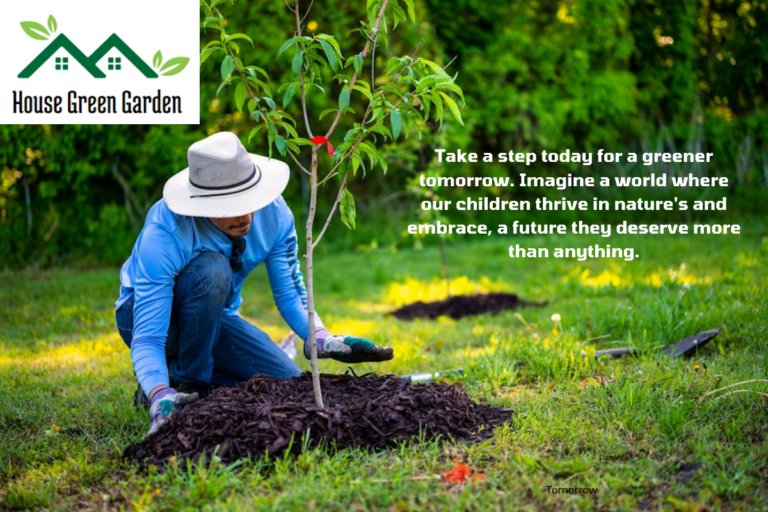Engaging in planting a tree in your garden is one of the best things you can do. It serves as an advantage environmentally, makes outdoor space look better, and ensures that there will be a happy future for generations to come. We would consider the steps involved in successfully planting a tree and why planting trees in your garden is essential.
Why Plant Trees in Your Garden?
Environmental Benefits
Trees are vital for keeping our planet healthy. They absorb carbon dioxide and release oxygen, aiding us to fight global warming. Trees have also been shown to absorb nearly 48 pounds of carbon dioxide annually, effectively reducing greenhouse gases.
Improving Biodiversity
Trees offer habitats and food sources to wildlife such as birds, insects and mammals. Planting indigenous trees within your compound may help support local ecosystems and raise biodiversity so diverse species can thrive.
Cleaning The Air We Breath
Nature’s air purifiers are trees. They remove contaminants such as sulfur dioxide, ammonia and nitrogen oxides from the atmosphere, improving its quality. It is crucial, primarily since urbanization has led to higher levels of air pollution.
Saving On Energy
Strategically positioned trees can offer shade during summer or act like windbreaks during winter, reducing air conditioning or heating requirements. Substantial energy savings can be realized through this move, lowering utility bills.
Increase Property Value
Your home value increases when you have matured trees dotting your landscape beautifully. Trees add beauty, privacy, and a sense of tranquillity to your garden, making it more appealing to potential buyers.
Choosing the Right Tree
Consider Your Climate
When selecting a tree species for planting, examine how well it grows under local climatic conditions. Native trees are often considered good options because they are adapted to the area’s conditions, thus requiring less maintenance activities.
Soil Type and Sunlight
Different trees grow well in various soil types and require different amounts of sunlight. Check your soil’s pH level and texture, then choose a tree that will grow in those conditions. Adequate sunlight is critical for the growth of any tree.
Size and Space
The mature size of the tree you plan to plant and the available space in your garden should be considered. Make sure the growing tree does not affect buildings, power lines or even other trees. Planting a tree very close to structures may lead to problems later on as it grows.
Steps To Plant A Tree
Select Best Time
The best time to plant a tree is during its dormant period, between early spring and late fall. During this period, trees face fewer temperature extremes, allowing them to establish their root system more efficiently.
Prepare The Site
Find an appropriate place in your garden that has enough room but also fulfils the sunlight and soil demands of the tree. Clear all grass, weeds or any form of litter around.
Hole Digging
Dig a hole two to three times larger than the root ball of the tree but no more profound than the root ball’s height. It allows the roots to spread out and establish more quickly. The sides of the hole should be roughened to prevent glazing, which can inhibit root growth.
Soil Amendment
Mix the excavated soil with organic compost to improve its fertility and structure. In addition, this will provide essential nutrients for a young tree and help it retain moisture.
Tree Planting
Place your tree in the centre of the hole so that the top of the root is level with the surrounding soil surface. Fill back around amended soil into a hole, gently patting it until all air pockets are gone, and then water graphically soak the plant well.
Mulching
Spread mulch around the tree’s base, extending to the drip line area. Mulch helps hold moisture into the ground, controls soil temperature and suppresses weed growth. Leave some inches of space between mulch material & trunk base to avert pest infestation by pests or decay.
Irrigation
Keep trees well watered, especially during the first few years as they grow. The earth should remain consistently moist without becoming soggy. Deep watering assists in rooting, encouraging profound natural growth and making it resistant to droughts.
Tying
Support newly planted trees with stakes if necessary. Tie the tree loosely with soft, flexible strings that allow trunk movements as it grows firmly.
Tree Pruning
Prune tree removing dead, damaged or diseased branches only. Pruned trees become shaped better; hence, they grow healthier. Do not over-prune because it stresses a plant and thus inhibits its growth or development.
Long-Term Care
Fertilizing Trees
Fertilize your tree once a year using a balanced fertilizer for proper nutrient supply. Do not use excess fertilizers since this may lead to an excessive growth rate, thus decreasing the plant’s resultant strength.
Pests and Diseases Monitoring
Regularly monitor your trees for pests and diseases. It is essential to detect infestations early enough because of the potential danger of their spread and the damage caused.
Wildlife Protection
Protect young trees from browsing by deer and rabbits, which could eat the bark or the soft shoots. Use tree guards or fences to keep animals off plants.
Conclusion
One way we can help improve our environment, make our gardens more attractive, and leave a lasting legacy for our children is by planting trees in them. Go through this guide on how to plant trees and take good care of them so you will have great fruits at the end of it all.
- Growing Bonsai: Tips for Miniature Tree Enthusiasts
- Buying Bonsai: Tips for Selecting Your Perfect Tree
- Bonsai Potting: Essential Tips for Tree Care Success
- Bonsai Maintenance: Essential Care for Tiny Trees
- Mastering the Art of Shaping Bonsai: A Beginner’s Guide
Source: Planting A Tree


